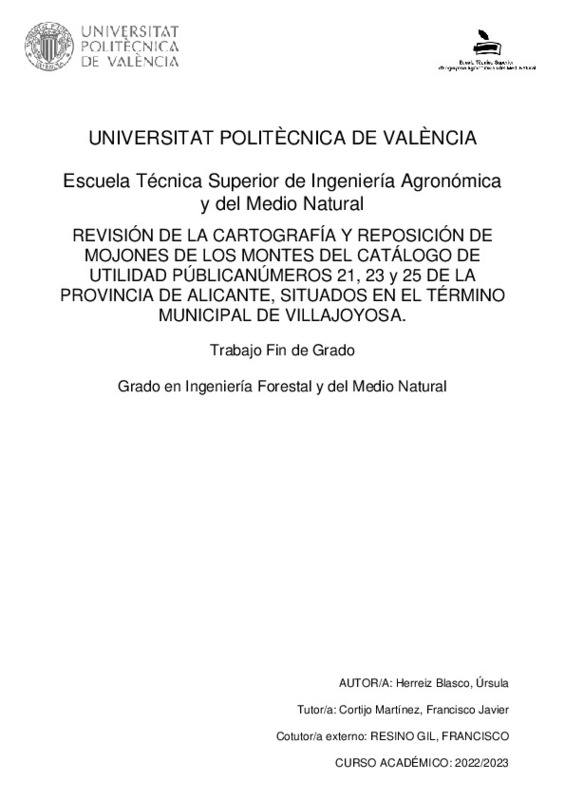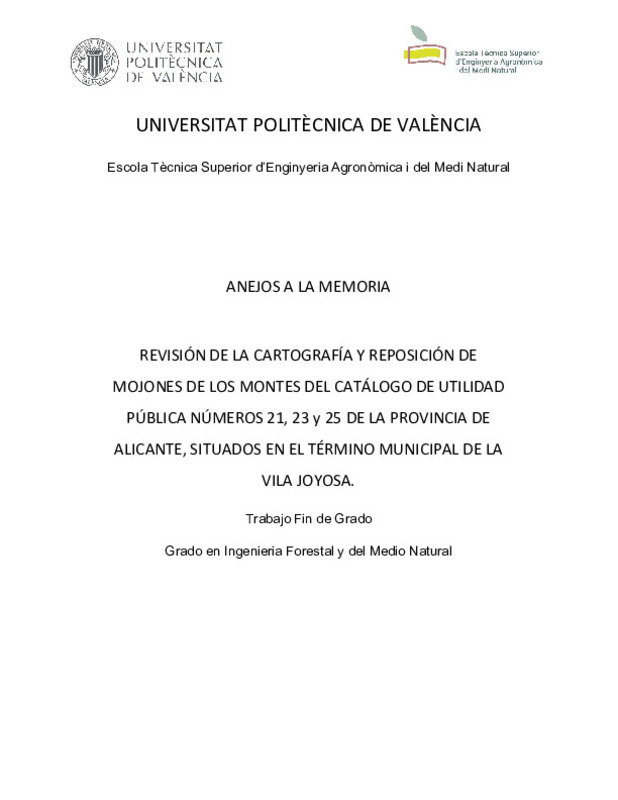|
Resumen:
|
[ES] En las últimas décadas ha habido un aumento considerable de las nuevas tecnologías y de los sistemas de información geográfica, la cartografía es un elemento esencial para el desarrollo y planificación de los proyectos, ...[+]
[ES] En las últimas décadas ha habido un aumento considerable de las nuevas tecnologías y de los sistemas de información geográfica, la cartografía es un elemento esencial para el desarrollo y planificación de los proyectos, así como para su ejecución en campo.
El catálogo de montes data del año 1901 donde se incluyeron los montes propiedad del estado para su protección, ya que anteriormente habían sido exceptuados de la desamortización de Pascual Madoz.
La necesidad de delimitar las propiedades, tanto públicas como privadas, llevaron a las administraciones a realizar los deslindes y posteriores amojonamientos de algunos de los montes del citado catálogo.
Desde el 2004, existe una cartografía del catálogo de montes de la Comunidad Valenciana, la cual presenta una serie de errores, ya que la realización de dicha cartografía fue a una escala muy alta y no al detalle como se pretende en este trabajo.
La principal finalidad de la cartografía de los montes, es la de trasladar los expedientes de deslinde y amojonamiento ya citados a un sistema de información geográfica, con el objetivo de tener una cartografía que los represente fielmente. De este modo se podrán planificar trabajos de aprovechamientos, ordenaciones, prevención de incendios, etc., con un margen pequeño de error.
Durante el trabajo se realizarán salida de campo a los diferentes montes para la toma de puntos de los mojones mediante gps, se calcularán las coordenadas mediante técnicas topográficas de los mojones no hallados y finalmente se creará una cartografía para cada monte con dichos datos.
Posteriormente y una vez obtenida la cartografía se plantea la reposición de los mojones no encontrados en campo, para que perduren en el tiempo y físicamente en el terreno se observe sin dudas la delimitación de los montes.
[-]
[EN] In recent decades there has been a considerable increase in new technologies and geographic information systems, and cartography is an essential element for the development and planning of projects, as well as for ...[+]
[EN] In recent decades there has been a considerable increase in new technologies and geographic information systems, and cartography is an essential element for the development and planning of projects, as well as for their execution in the field.
The catalogue of mountains dates back to 1901, when the mountains owned by the State were included for protection, as they had previously been exempted from the disentailment of Pascual Madoz.
The need to delimit the properties, both public and private, led the administrations to carry out the demarcations and subsequent demarcations of some of the mountains in the aforementioned catalogue.
Since 2004, there has been a cartography of the catalogue of woodlands of the Valencian Community, which has a series of errors, as the cartography was carried out at a very high scale and not in detail as intended in this work.
The main purpose of the mapping of the mountains is to transfer the aforementioned demarcation and boundary demarcation files to a geographic information system, with the aim of having a map that faithfully represents them. In this way it will be possible to plan works of exploitation, planning, fire prevention, etc., with a small margin of error.
During the work, field trips will be made to the different hills to take points of the boundary markers using GPS, the coordinates will be calculated using topographic techniques of the boundary markers not found and finally a cartography will be created for each hill with this data.
Subsequently, and once the cartography has been obtained, the replacement of the boundary markers not found in the field will be considered, so that they will last over time and the delimitation of the mountains can be observed physically on the ground without any doubts.
[-]
|








